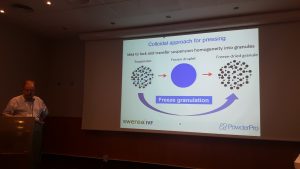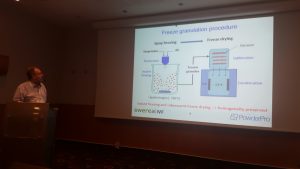Third day at ECerS2017 in Budapest with good meetings on how to apply Freeze Granulation for new challenges within processing of Ceramic powders, like diamonds and graphene, and also powder micro encapsulation.
News
ECerS2017 Second day

Second day at ECerS2017 in Budapest with discussions on applications of Freeze Granulation.
ECerS2017 First day seminar by Ola at PowderPro
On the first day of ECerS2017 in Budapest Ola Lyckfeldt hold a seminar on (klick on the title) – Freeze Granulation – A multi-tool for enhanced ceramic processing.
Anisotropy of functional properties of SiC composites with GNPs, GO and in-situ formed graphene
Anisotropy of functional properties of SiC composites with GNPs, GO and in-situ formed graphene
Ondrej Hanzel, Richard Sedlák, Jaroslav Sedláček, Valéria Bizovská, Roman Bystrický, Vladimír Girman, Alexandra Kovalčíková, Ján Dusza, Pavol Šajgalík
Abstract
This paper reports on anisotropy of functional properties of different silicon carbide-graphene composites due to preferential orientation of graphene layers during sintering. Dense silicon carbide/graphene nanoplatelets (SiC/GNPs) and silicon carbide/graphene oxide (SiC/GO) composites were sintered in the presence of yttria (Y2O3) and alumina (Al2O3) sintering additives at 1800 °C in vacuum by the rapid hot pressing (RHP) technique. It is found that electrical conductivity of SiC/GNPs and SiC/GO composites increases significantly in the perpendicular direction to the RHP pressing axis, reached up to 1775 S/m in the case of SiC/GO (for 3.15 wt.% of rGO). Also, thermal diffusivity was found to increase slightly by the addition of GNPs in the SiC/GNPs composites in the perpendicular direction to the RHP pressing axis. But, in the parallel direction, the addition of GNPs showed a negative effect. The formation of graphene domains was observed in reference sample SiC-Y2O3-Al2O3 sintered by RHP, without any addition of graphene. Their presence was confirmed indirectly by increasing electrical conductivity about three orders of magnitude in comparison to the reference sample sintered by conventional hot press (HP). Raman, SEM and TEM analysis were used for direct evidence of presence of graphene domains in RHP reference sample.
Keywords
Graphene nanoplatelets; Graphene oxide; Silicon carbide; Functional properties; Anisotropy
Mechanical and tribological properties of alumina-MWCNTs composites sintered by rapid hot-pressing
Mechanical and tribological properties of alumina-MWCNTs composites sintered by rapid hot-pressing
Ondrej Hanzel, František Lofaj, Jaroslav Sedláček, Margita Kabátová, Monika Tatarková, Pavol Šajgalík
Abstract
Alumina – MWCNTs composites were prepared using a novel approach. This process comprises functionalization of MWCNTs and stabilization of alumina-MWCNTs dispersion with subsequent freezing, which resulted in formation of granulated powders with homogeneous distribution of MWCNTs. The granulated powders were sintered by rapid hot pressing (RHP) at 1550 °C. Relative densities, microstructural analysis, tribological properties, fracture toughness and bending strength of prepared composites were investigated to reveal the effect of MWCNTs. Compared to pure alumina, bending strength and fracture toughness of dense alumina-5 vol.% MWCNTs composites decreased about 37% and 18%, respectively. At higher MWCNT contents, strength remained almost constant and fracture toughness slightly increased. Thus, the positive effect of CNTs on fracture toughness was demonstrated despite their counteracting effect on the refinement of the microstructure.
Keywords
Al2O3 – MWCNT composites; Rapid hot pressing; Tribological properties; Mechanical properties
Machinability analysis of multi walled carbon nanotubes filled alumina composites in wire electrical discharge machining process
Meinam Annebushan Singh, Deba Kumar Sarma, Ondrej Hanzel, Jaroslav Sedláček, Pavol Šajgalík
Abstract
The approach of machining ceramics with electrical discharge machining process is a great challenge till date due to its low electrical conductivity. Machining is made possible by reinforcing with a conductive phase which increases the overall electrical conductivity. Present work focuses on machining of multi walled carbon nanotubes filled alumina composites. Samples with concentrations ranging from 2.5 to 12.5 vol.% are considered for machining. At lower concentration of 2.5 vol.%, effective machining is not possible. Wire lag phenomena is observed during machining at 5 vol.% sample concentration. Proper machinability is observed with concentration of 7.5 vol.% or more. Also, long micro-cracks are obtained during machining that leads to the workpiece breakage. Spalling effect is observed as the most dominating material removal mechanism. A comparison between alumina composites and conducting metallic alloys were carried out for surface characteristics.
Keywords
Alumina; MWCNT; Wire EDM; MRR; Ra
Microstructure of plasma sprayed Al2O3-3wt% TiO2 coating using freeze granulated powder
Microstructure of plasma sprayed Al2O3-3wt% TiO2 coating using freeze granulated powder
Yiming Yao, Ola Lyckfeldt, Aurélien Tricoire, Dennis Lundström, Uta Klement
Abstract
This study is aiming at controlling the microstructure of plasma sprayed Al2O3-TiO2 composite coatings using freeze granulated powders. As sprayed and sintered Al2O3 + 3wt% TiO2 powders were air plasma sprayed with industry process parameters and compared with a commercial powder. The resulting coatings were investigated with respect to powder flowability, porosity and microstructure of the granules. The results showed that microstructure and melting fraction in the coatings could be tailored with the freeze granulation process and heat treatment conditions.
Keywords
Al2O3-TiO2, Freeze Granulation, Plasma Spray, Microstructure
ECerS2017
Welcome to our stand No 10 at the 15th Conference & Exhibition of the European Ceramic Society ECerS2017 July 9-13, 2017 in Budapest, Hungary. We look forward meeting with you and to discuss how we could support you with Freeze Granulation of your powder material for to make homogeneous granules for the manufacturing of high quality ceramics.
Fabrication of transparent MgAl2O4 spinel via spray freeze drying of microfluidized slurry
Fabrication of transparent MgAl2O4 spinel via spray freeze drying of microfluidized slurry
Ha-Neul Kim, Jin-Myung Kim, Mi-Ju Kim, Jae-Woong Ko, Young-Jo Park, Kisu Lee, Doo Hyun Choi
Abstract
Spherical granules were prepared from a monodispersed slurry by combining the microfluidization (MF) method and the spray freeze-drying (SFD) process. Starting with the prepared granules, transparent MgAl2O4 ceramics were fabricated through pressureless sintering followed by hot isostatic pressing. A comparison with a polydispersed slurry prepared by the ball-milling method showed successful fabrication of a mono-dispersed state by microfluidization method, and 80% visible in-line transmittance was obtained at a 600-nm wavelength from a process starting with a monodispersed slurry of low solid content. Microstructural analysis of the green bodies, the pre-sintered bodies, and the hot isostatic pressed bodies of the prepared MgAl2O4 ceramics revealed that the slurry dispersion should be controlled to a high level in order to suppress scattering sources such as pores and microcracks, which affect the in-line transmittance of visible light.
Keywords
Transparent; MgAl2O4; Spray freeze drying; Freeze granulation; Microfluidization
Large porous particles for respiratory drug delivery. Glycine-based formulations
Large porous particles for respiratory drug delivery. Glycine-based formulations
A.G. Ogienko, E.G. Bogdanova, N.A. Trofimov, S.A. Myz, A.A. Ogienko, B.A. Kolesov, A.S. Yunoshev, N.V. Zubikov, A.Yu. Manakov, V.V. Boldyrev, E.V. Boldyreva
Abstract
Large porous particles are becoming increasingly popular as carriers for pulmonary drug delivery with both local and systemic applications. These particles have high geometric diameters (5–30 μm) but low bulk density (~ 0.1 g/cm3 or less) such that the aerodynamic diameter remains low (1–5 μm). In this study salbutamol and budesonide serve as model inhalable drugs with poor water solubility. A novel method is proposed for the production of dry powder inhaler formulations with enhanced aerosol performance (e.g. for salbutamol-glycine formulation the fine particle fraction (FPF ≤ 4.7 μm) value is 67.0 ± 1.3%) from substances that are poorly soluble in water. To overcome the problems related to extremely poor aqueous solubility of the APIs, not individual solvents are used for spray freeze-drying of API solutions, but organic-water mixtures, which can form clathrate hydrates at low temperatures and release APIs or their complexes as fine powders, which form large porous particles after the clathrates are removed by sublimation. Zwitterionic glycine has been used as an additive to API directly in solutions prior to spray freeze-drying, in order to prevent aggregation of powders, to enhance their dispersibility and improve air-flow properties. The clathrate-forming spray freeze-drying process in the multi-component system was optimized using low-temperature powder X-ray diffraction and thermal analysis.
Keywords
Spray freeze-drying, salbutamol, budesonide, glycine, clathrate hydrates, dry powder inhaler formulation, large porous particles





